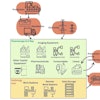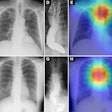VIENNA - MRA has been reported to be a simple and cost-effective method of performing angiography in the lower limbs. On the positive side, it's noninvasive, doesn't require iodinated contrast agents, and produces fewer artifacts than conventional angiography. However, MRA alone is not sufficiently accurate to guide treatment planning, according to Dr. Jan Winterer from the University of Bonn in Germany.
At the peripheral artery scientific sessions of this week's European Congress of Radiology, Winterer presented the results of a study that showed both overreading and underreading of MRA images of moderate and severe lower limb peripheral artery occlusive disease. The difficulties are due mainly to spatial resolution problems, he said.
"Clinicians demand that you (be able) to detect or exclude relative stenoses in terms of therapeutic consequences, either with surgical intervention or PTA," Winterer said. Because the decision to intervene or not intervene depends on angiographic results, they must be able to reliably distinguish moderate from high-grade stenosis.
In a prospective study comparing MRA to digital subtraction angiography (DSA), the researchers looked at 46 patients aged 47-96 years to assess the accuracy of MRA in distinguishing moderate (50%-70%) from severe stenosis as compared to DSA results. All patients had at least one iliac or peripheral artery stenosis of > 50% on DSA.
"We divided the peripheral arterial tract into several segments, including the iliac, femoral, popliteal, and crural levels," Winterer said. "MRA was evaluated using multiangulated subtraction MIPs. We evaluated 155 stenoses altogether, with a balanced number of moderate and high-grade stenoses, varying the distribution."
The results were interpreted by five readers, including two radiologists experienced with MRA and three interventional radiologists who were inexperienced in MRA. Interobserver variability among readers was also tracked.
MR images were acquired using a fast contrast-enhanced high-resolution 3-D technique on a Siemens Magnetom Vision Plus 1.5-tesla scanner using a body coil. TR/TE was 6.21.9, with MS flip angle of 30, a 375 x 500-mm field of view, and an acquisition of 96-mm coronal slabs at 192 mm x 512 mm. Time of acquisition was 28 seconds, and spatial resolution was 2 x 1 x 2 mm, Winterer said.
Beginning with the popliteal and crural levels, then continuing to the iliac and femoral level, the researchers acquired a precontrast series of images, followed by a 20-ml injection of Gd-DPTA contrast solution. Four continuous acquisitions were obtained, with a delay of 16 seconds. MRA was evaluated using multiangulated subtraction maximum intensity projection (MIP).
According to the results, in all vessel segments the experienced observers reported sensitivity of 76%, and specificity of 66%. Maximum accuracy was 69% for all vessels, 70% in the pelvic area, 77% in the femoropoplitial area, and 67% in the crural vessels. For all segments, Cohen's Kappa was 0.61 in the experienced readers and 0.24 to 0.49 in the less experienced readers.
"There was a great range between sensitivity and specificity among the less experienced readers," Winterer said. "Some readers achieved high sensitivity but low specificity, and the other way around was also found.... The best results were found in the femoral and popliteal level; the results were quite disappointing at the crural level. In the iliac arteries we got confusing results. Some of the experienced readers got some bad values regarding the predictive values. In MRA even some experienced readers found high-grade stenoses, but they weren't proven in DSA."
Winterer concluded that contrast-enhanced 3-D MRA as an exclusive imaging approach does not allow the reliable assessment of critical stenoses, noting that MRA both underestimated and overestimated stenoses compared with DSA, and there was marked interobserver variability in interpretation. Moreover, he said, the team's prior experience with curved multiplanar reconstruction (MPR) software and Gd-DPTA contrast agent did not improve the results significantly.
"There are some studies that say don't use MIPs at all, but I don't think this is the main problem," Winterer said. "I think the main problem is the spatial resolution, 2 x 1 x 1 mm. This is the voxel size. If you've got a vessel size of 1 cm diameter, it's very hard to distinguish between a lumen of 2 or 3 mm because of the voxel size."
By Eric Barnes
AuntMinnie.com staff writer
March 6, 2001
Click here to post your comments about this story. Please include the headline of the article in your message.
Copyright © 2001 AuntMinnie.com



















